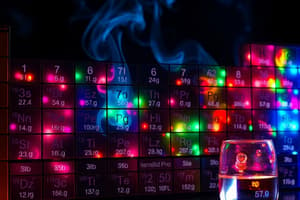Podcast
Questions and Answers
What happens to atomic radii as you move from left to right across the periodic table?
What happens to atomic radii as you move from left to right across the periodic table?
- Atomic radii increase
- Atomic radii remain the same
- Atomic radii decrease (correct)
- Atomic radii fluctuate
Ionic radii increase from bottom to top in a group.
Ionic radii increase from bottom to top in a group.
False (B)
What is the term used to describe the phenomenon where inner electrons shield outer electrons from the nucleus's attraction?
What is the term used to describe the phenomenon where inner electrons shield outer electrons from the nucleus's attraction?
Shielding effect
The energy needed to remove an electron from a neutral gaseous atom is called __________.
The energy needed to remove an electron from a neutral gaseous atom is called __________.
Match the following elements with their ionization energy characteristics:
Match the following elements with their ionization energy characteristics:
Which of the following statements is true regarding first ionization energy?
Which of the following statements is true regarding first ionization energy?
Cations are formed when an atom gains electrons.
Cations are formed when an atom gains electrons.
In a group of elements, atomic radii __________ as you move down the group.
In a group of elements, atomic radii __________ as you move down the group.
Flashcards
Atomic Radius
Atomic Radius
The size of an atom, measured as the distance between the nucleus and the outermost electron.
Ionic Radius
Ionic Radius
The size of an ion (charged atom), measured as the distance between the nucleus and the outermost electron.
Electronegativity
Electronegativity
The tendency of an atom to attract electrons towards itself when forming a chemical bond.
Ionization Energy (IE)
Ionization Energy (IE)
Signup and view all the flashcards
Periodic Trend: Atomic Radius Across Period
Periodic Trend: Atomic Radius Across Period
Signup and view all the flashcards
Periodic Trend: Atomic Radius Down Group
Periodic Trend: Atomic Radius Down Group
Signup and view all the flashcards
Shielding Effect
Shielding Effect
Signup and view all the flashcards
Periodic Trend: Ionization Energy Across Period
Periodic Trend: Ionization Energy Across Period
Signup and view all the flashcards
Study Notes
Periodic Trends
- The periodic table organizes elements based on electron configurations, revealing patterns known as periodic trends.
- Atomic and ionic radii are influenced by factors like effective nuclear charge and electron shielding.
Atomic Radii Trends
- Atomic radii decrease across a period (left to right) due to increasing nuclear charge and the reduced shielding effect.
- Atomic radii increase down a group due to the increasing number of electron energy levels.
Ionic Radii Trends
- Metal cation radii are smaller than their neutral atom counterparts, as valence electrons are lost.
- Non-metal anion radii are larger than their neutral atom counterparts, as extra electrons increase electron-electron repulsion.
Explanations of Trends
- Trend 1 (across periods): Effective nuclear charge increases, pulling electrons closer to the nucleus, leading to smaller atomic and ionic radii.
- Trend 2 (down groups): Presence of increasing electron shells; more electron shielding occurs, hence wider spaced orbitals, resultant larger volumes .
Ionization Energy
- Ionization energy is the energy needed to remove an electron from a gaseous atom.
- Ionization energy increases across a period because the effective nuclear charge increases, making it harder to remove an electron.
- Ionization energy decreases down a group, since increasing electron shielding makes it easier to remove an electron.
Studying That Suits You
Use AI to generate personalized quizzes and flashcards to suit your learning preferences.




